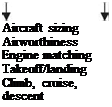Functional Tasks during the Conceptual Study (Phase 1: Civil Aircraft)
Because this book is concerned only with Phase 1, it is important to delineate functional task obligations assigned to individual designers – also known as top-level definition. Market specifications should first be delineated to develop task content, as shown in Chart 2.5 for the mission profile. Payload determines the fuselage size and shape and leads into undercarriage design, depending on wing and engine positioning. Wing design largely determines the range, operational envelope, and field – performance objectives. Considering all requirements together, the aircraft configuration evolves: There can be more than one candidate configuration (e. g., high or low wing, nacelle location, and empennage arrangement).
Aircraft configuration starts with the fuselage layout followed by the steps worked out in this book. The military aircraft design approach is not significantly different except that the payload is armament, which is generally underslung or kept inside the fuselage bay.
Mission Profile
![]()
![]() (
(
Payload Range
(Configures fuselage and undercarriage) (Configures wing, empennage, nacelle,
high-lift devices, control surfaces)

 ▼
▼
Seating arrangements for the capacity Cargo-space allocation Loading facilities
Doors, emergency exits, and windows arrangement Environment control
Cabin amenities (e. g., overhead lockers, galley, toilet)
Chart 2.5. Top-level definition (Phase 1, Conceptual Study)
Chart 2.5 can be divided into functional work group activity to focus attention on specific areas – necessarily in IPPD environment for MDA. Other chapters of this book address specific work group activity.











